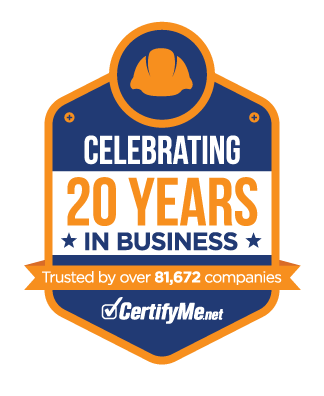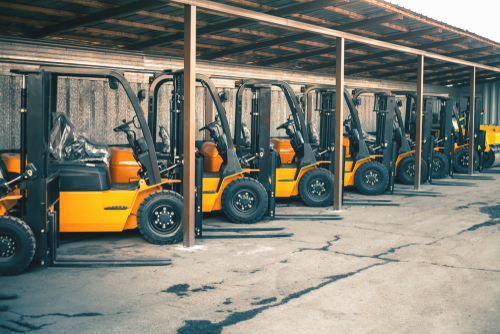Proper Forklift Parking: OSHA Guidelines and Best Practices
Posted by: admin on March 20, 2025
Why Forklift Parking Matters
Workplace safety depends on correct forklift operation, including secure parking procedures. Compliance with OSHA forklift parking requirements prevents accidents and reduces regulatory risks. Operators must understand parking protocols, common mistakes, and shutdown procedures to avoid costly violations. Forklifts left improperly parked can lead to unintended movements, collisions, and tip-overs, putting both operators and nearby workers at risk. Ensuring proper forklift parking helps maintain compliance and fosters a safer work environment by reducing workplace hazards.
OSHA Forklift Parking Guidelines
What Are OSHA’s Requirements for Parking Forklifts?
OSHA mandates strict parking rules to prevent workplace hazards. These include:
- Selecting a firm, level surface to avoid movement.
- Blocking wheels if parked on an incline to prevent rolling.
- Parking only in designated areas unless disabled to ensure accessibility.
- Engaging the parking brake fully to keep the forklift stationary.
- Lowering the lifting mechanism completely to enhance stability.
- Neutralizing controls to prevent unintended movement and ensure the forklift remains secure.
Failure to follow these guidelines can result in penalties, injuries, or property damage. Ensuring all forklift operators are aware of these requirements is a fundamental aspect of workplace safety and compliance.
Can a Forklift Be Left Running Unattended?
Forklifts cannot remain running without an operator present. OSHA defines a forklift as unattended when the driver is more than 25 feet away or out of sight. When left unattended, the ignition key must be removed, and the forks lowered to the ground. Leaving a forklift running without supervision increases the risk of accidental engagement, leading to property damage or injuries. Additionally, unauthorized personnel may attempt to operate the forklift, creating further safety concerns.
Operators must always follow strict shutdown procedures before stepping away from their equipment. Taking a few extra moments to secure the forklift properly can prevent potential hazards and costly damages.
Step-by-Step Forklift Shutdown Procedures
Following proper shutdown procedures ensures safety and compliance:
- Position the forklift correctly within a designated parking area, ensuring it does not obstruct pathways, emergency exits, or loading zones.
- Fully engage the parking brake to keep the forklift stationary, preventing unintended movement.
- Lower forks until they rest flat on the ground, eliminating potential tripping hazards and reducing strain on hydraulic systems.
- Tilt the mast forward so the forks are parallel to the surface, ensuring stability and preventing accidental tipping.
- Turn off the engine and remove the key to prevent unauthorized operation and secure the forklift from accidental engagement.
- Dismount carefully, maintaining three points of contact, such as two hands and one foot or two feet and one hand, to prevent slips or falls.
Properly following these steps every time a forklift is parked significantly reduces workplace accidents and enhances operational safety.
Common Forklift Parking Violations and How to Avoid Them
Violations of OSHA’s forklift parking rules lead to fines and workplace hazards. Examples include:
- Parking on inclines without blocking wheels, leading to potential rolling hazards.
- Leaving forklifts in unauthorized areas, creating obstructions and safety risks.
- Failing to lower forks before leaving the forklift, increasing the likelihood of tripping hazards.
- Not engaging the parking brake can result in unintended movement and collisions.
- Leaving the key in the ignition, making the forklift susceptible to unauthorized use.
Avoiding these violations requires consistent adherence to regulations, regular safety training, and routine equipment checks. Supervisors should conduct periodic inspections to ensure that operators are following correct parking procedures.
Best Practices for Parking in Designated Areas
Why Use Designated Parking Zones?
Designated forklift parking areas reduce congestion and enhance workplace safety. Properly marked zones ensure clear pathways, prevent accidental obstructions, and streamline warehouse traffic. Implementing structured parking practices minimizes risks and ensures forklifts remain in easily accessible, low-risk locations.
Tips for Maintaining Safe Parking Areas
- Clearly mark forklift parking zones with visible signs and floor markings to direct operators to the appropriate locations.
- Regularly inspect parking areas for obstructions or hazards such as debris, spilled liquids, or damaged surfaces.
- Train workers to recognize and respect designated parking spaces, reinforcing the importance of following established safety protocols.
- Ensure sufficient lighting in forklift parking areas to improve visibility and prevent accidents, especially in warehouses and loading docks with low natural light.
- Encourage proper spacing between parked forklifts to allow safe maneuverability and easy access when starting a shift.
Adopting these best practices contributes to a safer and more efficient workplace, reducing the likelihood of accidents and improving overall operational efficiency.
CertifyMe: Your Partner in Forklift Safety
Understanding OSHA forklift parking requirements is essential for compliance and workplace safety. CertifyMe provides online forklift certification that ensures operators follow best practices for safe operation and secure parking.
With a streamlined, user-friendly platform, CertifyMe allows operators to complete their training efficiently while ensuring full OSHA compliance. Companies can reduce workplace hazards, avoid regulatory penalties, and promote a safety culture by enrolling in our certification program.
Take the next step in workplace safety—train your team with CertifyMe today to ensure your workforce remains compliant and secure.
Welcome to CertifyMe.net
CertifyMe.net has offered online forklift certification since 1999. With Our Convenient online program. your employess can earn their certification in an hour or less.
Browse Online Certifications:
This low-cost program can be compeleted anytime, anywhere!







